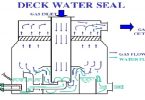Points to pounder for inert gas :
Inert gas systems on ships Inert gas is produced on board of mainly crude of oil carriers, gas carriers and Chemical carriers, and in Bulk carriers when carrying fish flower, and in refrIGerating ships when carrying fruit products, by using either a flue gas system or by burning Marine Diesel Oil ( MDO or MGO) in a dedicated inert gas generator, or produced clean Nitrogen by an dedicated Nitrogen Generator.
IG keeps the oxygen content of the tank/cargo hold atmosphere below 8%, thus making any air/hydrocarbon gas mixture in the tank too lean to IGnite. IG is most important during discharging of cargo on tankers and during the ballast voyage when more cargo and/or hydrocarbon vapour is likely to be present in the tank atmosphere.
Inert gas can also be used to purge the tank of the volatile atmosphere in preparation for gas freeing – replacing the atmosphere with breathable air – or vice versa. Inert Gas can also be used for emptying cargo lines or Cargo pumps.
Sources of inert gas on tankers including combination carriers are:



IG density 1.044t/M3 and Air density at atm pr : 1.22 t/M3 ..how is then iG heavier then air sir..can you confirm or correct me pls
Density of IG is mentioned as 1.044 t/m3 , however the density of air is around 1.22 t/m3 at atm pressure,how is then that IG is heavier then air sir..can you clarify or correct me pls
Hello Sir
what is the inert gas combination and its range in an IG O2 Analyser?